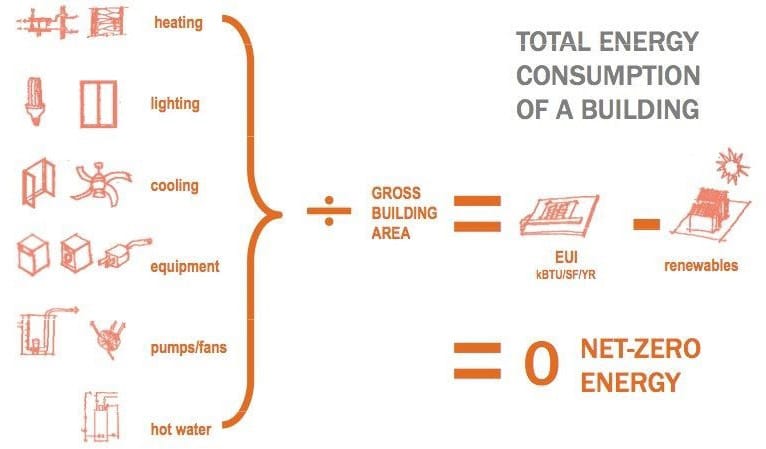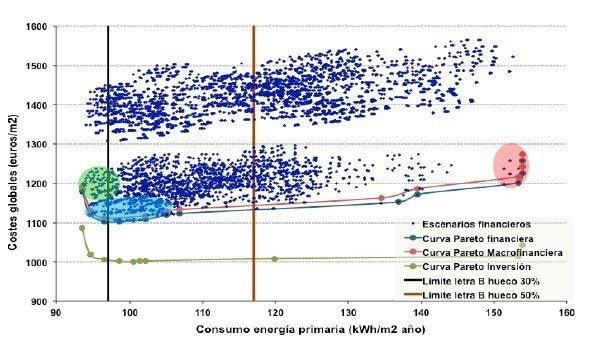Zero energy buildings. What exactly?
The building sector is responsible for approximately 40% of energy consumption, resulting in both significant environmental impacts (CO2 emissions associated with 36%), and a relevant operating costs at the macro level and building to building.
Beyond statistics, these values can be landed by sector; in Spain, the approximately 100km2 existing office space are responsible for the second largest energy consumption in the building (just behind the residential, which has built more than twenty times larger).
In this context, the European Directive of behavior in Buildings (EPBD its acronym in English), raised a number of guidelines to consider to reduce the energy impact of buildings. Among them, the directive raises the obligation to construct buildings of almost zero energy (net zero energy buildings, NZEB its acronym in English) in 2018 and 2020 for public buildings for the rest.
However, it’s been almost six years after the publication of the EPBD and there is still more shadows than light; What zero energy buildings are ?, Is the office sector ready for change ?, Are there examples of NZEB offices in Spain ?.
Diversity of opinions in zero energy buildings
As we mentioned already come a long way since the publication of the EPBD and, nevertheless, not yet clear what is a zero-energy building. Directive, understanding the complexity of the definition, proposed a first frame: “… that building a very high level of energy efficiency …. The amount almost zero or very low energy required should be covered to a very significant extent by energy from renewable sources, including from energy from renewable sources produced in situ or in the environment. ” This results in the following scheme;

However, there are multiple interpretive elements in this definition (not counting or equipment, consider invoice or design, define “environment” in the production of renewable, etc.), which considering the realities of each country resulting in different definitions by member states.
By way of example and tertiary buildings in Austria it is considered a limit value of 170kWh / m2 year, while in Denmark the value is 25kWh / m2 year. BPIE (European think tank for the promotion of energy efficiency in buildings) has published a comparison between member states.
In the case of Spain, there is still no official definition of zero energy building, although different sources value a requirement 60 kWh / m2 year limit consumption of non-renewable primary energy for commercial buildings.
What mean NZEB buildings in Spain: you are prepared the sector?
Hard to understand these values without reference to guide us. Official data from the IDAE (Ministry of Industry, Energy and Tourism), in Spain the average consumption of office buildings is 230kWh / m2 year, that is almost 4 times higher than the proposed limit.
Although the comparison has its nuances, studies oriented office segment clarify the scope of the proposal. Tobeem the project, it is estimated that the cost of construction of an office building in Madrid zero energy can be between 1,100-1,200 € / m2 (excluding investment costs in renewable). This can assume a total cost (in lifecycle) lower than the current type office building, but a cost overrun in relation to building optimal cost (one who has the best economic cost vs. energy consumption).

In short, they can be built cheaper buildings (life cycle) or at the same price (investment) and consume significantly less energy. But for zero energy are required, on average, an extra cost investment.
Two questions seem obvious: who must pay the extra cost of these investment ?, and the various actors involved, for the optimal design of zero energy buildings are ready? To the first question we have no answer today, although we could expect some kind of subsidization at the time that specific regulations be published. A second, perhaps we can respond to existing experiences.
Office buildings zero energy in Spain
There is currently no clear inventory of buildings zero energy in Spain, much less broken down by sector. While it is possible to know the statistics of qualified letter A, or with the highest accreditations in private certifications (LEED or BREEAM type) buildings, the fact that there is no obligation or clear definition of buildings NZEB has limited the count of cases.
It is difficult, in this context, list office buildings, beyond the headline, really be zero energy. However, considering international references and measured data you can be put concrete examples of buildings NZEB in our latitudes. To give some examples, the Center for Science in Benasque Pedro Pascual, the Milla Digital in Zaragoza, or the seat of IDOM building in Madrid.
In conclusion, nobody said it was easy, and there is still a long way to go, but zero energy buildings are a reality, and have to work to move from a common scenario singular cases. The first will have a clear competitive advantage.